Strawberry Production
Strawberries are produced in Florida using a raised bed plasticulture system. Beds are made and fumigated from August‒September, and planting of strawberry transplants occurs from early September‒October. Black medic (Medicago lupulina L.) is an annual broadleaf weed that emerges from the planting holes in the plastic mulch to compete with the crop and impede harvest. Current fumigant practices do not adequately control black medic.
Emergence
Knowing when weeds emerge is important for executing effective management techniques. When weeds are too large, control measures are ineffective due to increased herbicide tolerance, increased crop shielding for postemergence applications, and accidental reintroduction of seed back into the seedbank. Growing degree day (GDD) predictions are a measure of heat accumulation over time used to predict biological phenomenon such as emergence, growth, and development. Recommendations that follow will list both the date it was observed as well as the GDD. GDD were calculated with base 0, summing temperature over time from the point transplanting and punching holes in the plastic mulch. GDD are calculated by subtracting the base temperature (which is 0 in the case of black medic emergence) from the daily average temperature:

Black medic field emergence has been observed in mid-to-late November (862 GDD) and reaches peak emergence in late December (1416 GDD) (Sharpe 2017). Upon emergence, growth and development of black medic is quite variable between sites, so proper scouting is essential to coordinate spray timings with susceptible plant sizes (Sharpe et al. 2017a).
Plant Growth
After emergence, black medic first produces a unifoliate leaf followed by the first true trifoliate leaf (Figure 1). Leaves will continue to be produced in an alternate arrangement, and the plant initially maintains a compact growth habit. When the plant reaches 7 to 10 leaves, it then begins to develop branches (Figure 2). Two to four branches will arise near the planting hole, but up to seven branches have been observed when growing in competition with strawberry (Sharpe et al. 2017a).
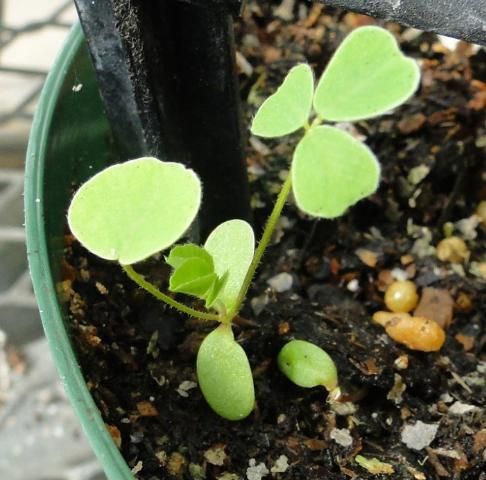
Credit: Shaun M. Sharpe, UF/IFAS
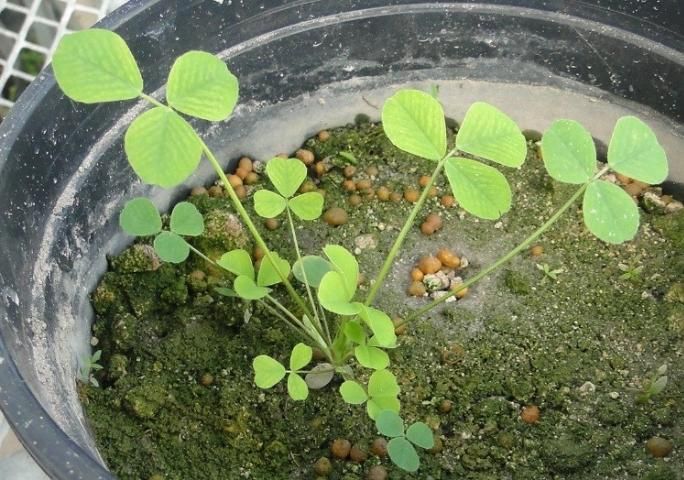
Credit: Shaun M. Sharpe, UF/IFAS
Black medic growth is slow initially, but rapid stem elongation occurs from early December to late February. It is during this phase that black medic becomes more visible in the field, as it grows beyond the edges of the strawberry plant (Figure 3) or becomes more prominent within the canopy (Figure 4). In both situations, black medic utilizes resources meant for the strawberry plant (primarily nutrients) and impedes harvest by obscuring the presence of the fruit. As black medic stems elongate, they produce yellow, raceme flowers (Figure 5), which will give rise to beige-colored, immature seeds that turn ebony-black upon ripening (Figure 6).
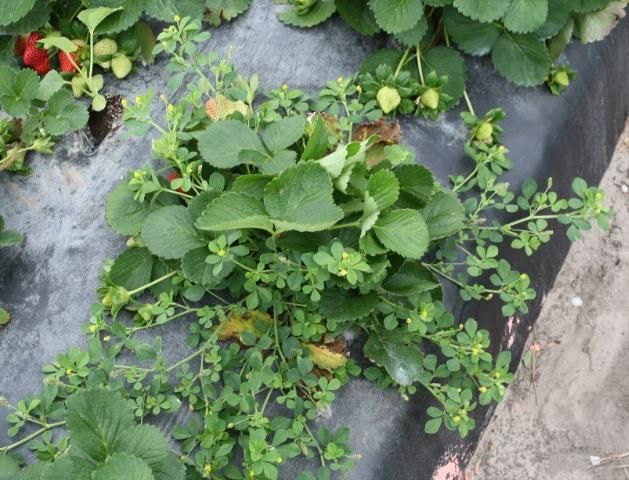
Credit: Shaun M. Sharpe, UF/IFAS
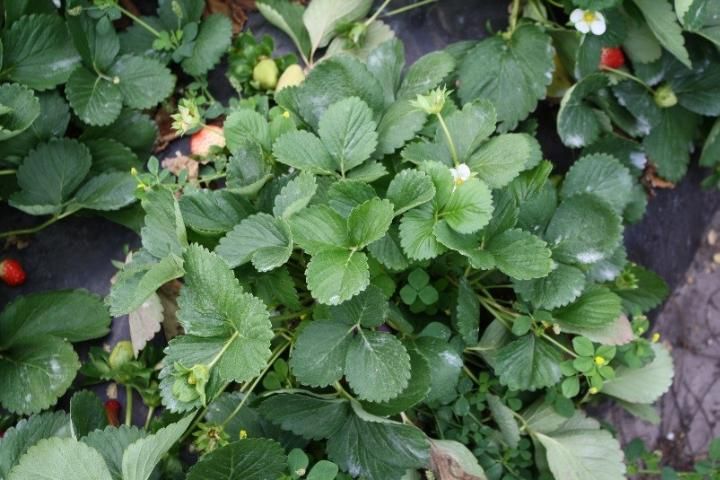
Credit: Shaun M. Sharpe, UF/IFAS
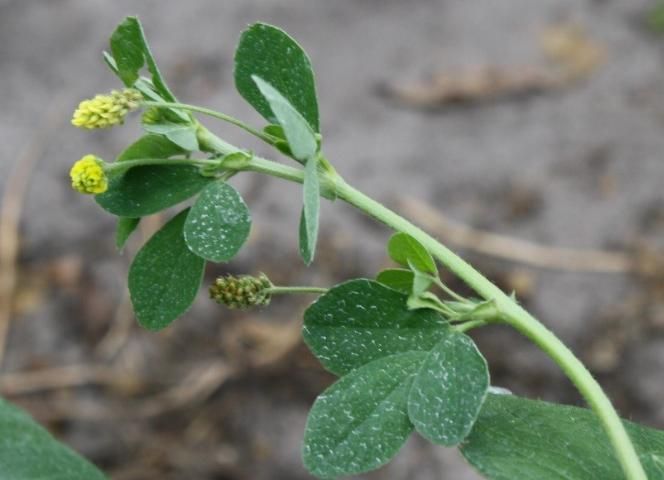
Credit: Shaun M. Sharpe, UF/IFAS
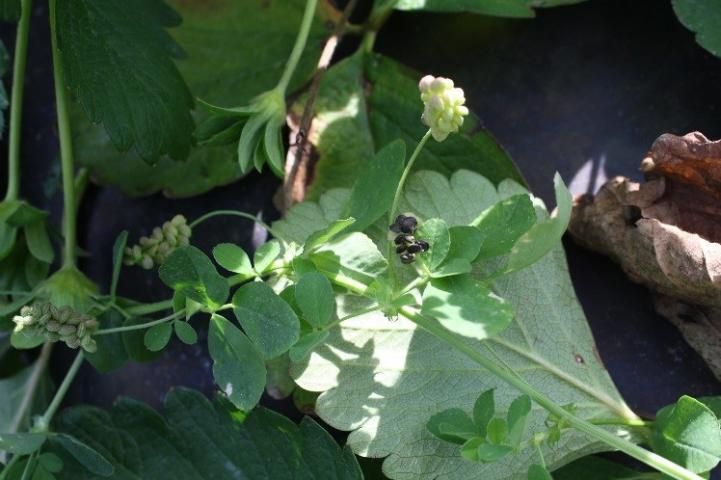
Credit: Shaun M. Sharpe, UF/IFAS
Scouting
Scouting should occur routinely prior to the anticipated emergence date. Black medic emerges from the soil in the planting hole. The strawberry crop may obscure its presence, so physically moving the strawberry leaves to evaluate at the planting hole is critical to identification. Black medic populations are patchy, so scouting should occur both across and within rows to best intercept a patch. Take good notes on location, density, and size of patches to help evaluate control methods moving forward.
Stinger®
Stinger® (active ingredient clopyralid) is the only registered postemergence over-the-top herbicide available for use in Florida strawberry production. Spray timing is critical for black medic control. According to the specimen label, black medic can be controlled with Stinger® at ¼ to ½ pint acre-1 in 20 to 60 GPA of water when the plant is up to the 5-leaf stage (Anonymous 2015) (Figure 1). Black medic was controlled with direct application of Stinger® when applied at the 0.5 to 1 cm stem length growth stage (60% necrosis, 80% biomass reduction) (Sharpe et al. 2016) (Figure 2). In 2014, this growth stage occurred across four sites between November 23 and December 7, which corresponded to between 890 and 1152 GDD from transplant and hole punch (Sharpe et al. 2017a). Stinger® should not be applied later than the 0.5 to 1 cm growth stage and certainly not after the black medic plants begin to flower. Later applications, such as in January, are ineffective, as there is limited spray penetration through the strawberry canopy (Sharpe et al. 2017b), black medic is larger and more tolerant to Stinger® (Sharpe et al. 2016), and Stinger® has limited mobility inside the plant (Sharpe 2017). Stinger® also has a 7-day pre-harvest interval which limits its use once harvest commences. Strawberry plants may have some leaf malformations in response to Stinger® applications. These malformations may present as either leaf cupping or leaf rolling (Figure 7). Increased leaf malformations tend to occur when temperatures are warmer, either prior to or after application (Sharpe 2017). Leaf malformations are generally temporary and a result of secondary effects of the herbicide. Minor plant stunting may occur (Sharpe 2017) but reductions in the number of flowers or yield have not been observed across many rates and timings (Sharpe 2017; Boyd and Dittmar 2015).
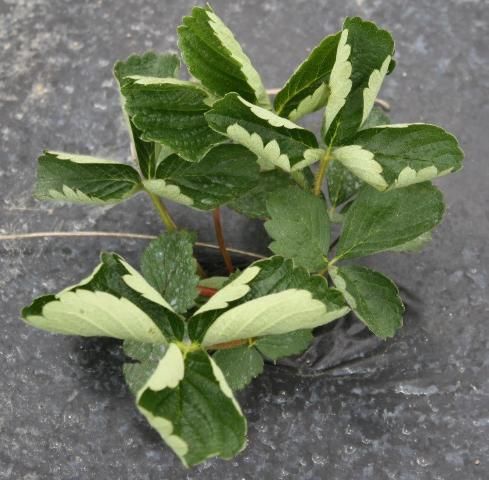
Credit: Shaun M. Sharpe, UF/IFAS
Do not use Stinger® if relay cropping. Consult the label for plant-back timings for other crops. Some cropping intervals may extend up to 18 months. Do not compost treated plant material due to the persistence of Stinger®. Stinger® is broken down in the soil by microbial activity but the rate is dependent on environmental conditions, including moisture, temperature, and organic matter (Anonymous 2015).
Hand Weeding
Hand-weeding of black medic is an alternative to herbicide application and is advisable for controlling larger plants. Hand-weeding should occur prior to the rapid growth phase for stems. This is largely site-dependent but has been observed on December 1, 2014 (1,050 GDD) at one site and between January 22, 2015 to February 9, 2015 across three other sites (Sharpe et al. 2017a). To minimize the return of seed to the seedbank, hand weeding should be done at the latest, prior to the formation of seed. First seed production at one site was on December 24, 2014 (1,416 GDD) while it occurred between February 2, 2015 (2,045 GDD) to March 3, 2015 (2,500 GDD) across three other sites (Sharpe et al. 2017a). If seeds have formed on the plants, it is advisable to remove the plant material from the field, depositing at least on the field borders if not entirely removed from the field.
Row Middles
For control of black medic in the row middle, broad-spectrum herbicides are available for postemergence control. Glyphosate is available under various formulations, with a 14-day preharvest interval. Please consult the label for use rates. Injury may occur from translocation from exposed daughter plants from untrimmed runners. Paraquat (Gramoxone® or Firestorm®) has a 21-day PHI and can be applied up to three times per season as a directed spray.
References
Anonymous. 2015. Stinger® herbicide specimen label. The Dow Chemical Company.
Boyd, N. S., and P. J. Dittmar. 2015. "Impact of application time and clopyralid rate on strawberry growth and yield." Weed Technol. 29: 821‒826.
Sharpe, S. M., "Use of clopyralid to control black medic (Medicago lupulina) in Florida strawberry (Fragaria ×ananassa) production" PhD dissertation, University of Florida, 2017, 130 p.
Sharpe, S. M., N. S. Boyd, and P. J. Dittmar. 2016. "Clopyralid dose response for two black medic (Medicago lupulina) growth stages." Weed Technol. 30: 717‒724.
Sharpe, S. M., N. S. Boyd, P. J. Dittmar, G. E. MacDonald, R. L. Darnell, and J. A. Ferrell. 2017a. "Control recommendations for black medic (Medicago lupulina) based on growth and development in competition with strawberry." Weed Sci. 1‒8.
Sharpe. S. M., N. S. Boyd, P. J. Dittmar, G. E. MacDonald, R. L. Darnell, and J. A. Ferrell. 2017b. "Spray penetration into a strawberry canopy as affected by canopy structure, nozzle type, and application volume." Weed Technol. 1‒5.